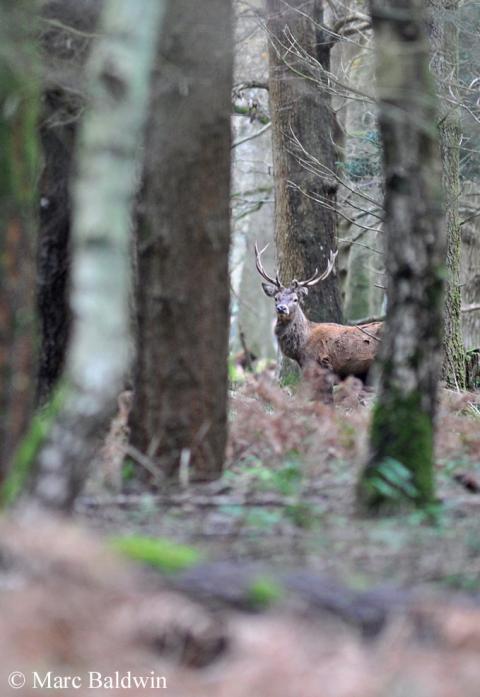Red Deer Habitat
Red deer appear to predominantly be a species of open deciduous and mixed woodland although they are highly adaptable animals and can be found in conifer plantations, open grasslands and meadows, river valleys and flood plains, parkland, scrub and on moorland. Indeed, their propensity to spend significant amounts of their time in ponds at the Knepp Estate and Richmond Park have led some to suggest they may even be a predominantly riverine species. They are rare in large areas of very dense forest and aren’t typically associated with visits to gardens, as muntjac and Roe can be. This species is generally found below the treeline, although where they persist at higher altitudes (e.g. the Alps) they may be found feeding above the treeline during the summer.

In Britain, Red deer are found in their greatest numbers on open moorland, although this is more a reflection of human management of the species than natural propensity. They are also found in ancient and plantation woodland, especially where such areas are peripheral to agricultural land used for growing crops. During the summer months in Scotland the deer are generally to be found on high ground with new heather growth during the day; typically, they will move to lower ground during the winter months. The Red deer sexes live apart during most of the year, with hinds monopolizing more productive grassy areas, and stags confined to nutrient-poorer heather regions.
On Scotland’s Isle of Rum, Red deer make use of the seaweed habitats during the winter months. Zoologist Larissa Conradt, currently at the University of Sussex in Brighton, studied the use of this habitat by deer during her time with Cambridge University’s Large Animal Research Group. In 2000, Conradt published a paper in the Journal of Zoology documenting her findings. It seems that, although seaweed comprises less than one percent of the total habitat area of Rum, it forms an important part of the deers’ diet, with stags and hinds spending on average 18% and 12% of their time, respectively, foraging there.

The stags and hinds remained segregated while feeding; the two sexes generally used different bays and, where they used the same bay, they used different fractions of the seaweed (males preferred washed up seaweed, while hinds actively grazed on growing algae). Analysis of the rumen contents of an adult hind revealed that just over 17% was seaweed, with Laminaria kelp (the Phaeophyceae, or brown algae) being the most common – this is perhaps not surprising, given that it is also the most nutritionally-rich species of algae growing in the bays.
Conradt noted that some of the deer seemed especially keen on the seaweed and were seen to watch the coast long before low tide and make a bee-line for the beach as soon as the tide had gone out sufficiently far to permit grazing. Perhaps most interesting was the finding that the use of seaweed habitat was closely correlated with whether their mothers used the habitat, which implies that some deer may learn to include seaweed in their diet.

Red deer have adapted to a wide range of different environments, but strong preferences for certain types of habitat are apparent in some parts of their range. Additionally, habitat use may be heavily influenced by weather, with stags seeking shelter more readily than hinds, even if this means occupying sites with lower quality resources. Indeed, the observation that males seem more sensitive to the prevailing weather than females has been put forward to explain the sexual segregation found in this species – it is known as the ‘weather sensitivity hypothesis’ and is discussed in the Behaviour and Sociality section.
Observational data collected by mammologists at the Polish Academy of Sciences on managed plots in the Bialowieza Primeval Forest during 2008 suggest that Red deer show a preference for feeding in forest gaps. The study, published in the journal Forest Ecology and Management during 2009, found the visitation frequency of all the ungulates combined (i.e. European bison, Red deer, Roe deer, moose and wild boar) was almost twice as high to forest gaps as to areas of closed forest; Red deer showed the strongest preference of any species, with single visits to gaps lasting almost seven times longer than visits to sites in the closed forest.
It seems that the deer were attracted to the gaps because of the relative abundance of regenerating trees and the broader array of tree species found there. Biologically-speaking, the process is fairly straightforward – when gaps are created in a previously closed canopy, the increased light level leads to an increase in the growth of the trees, while also allowing the growth of some that may have been shaded out by the established trees. This abundance of new growth attracts plant predators.